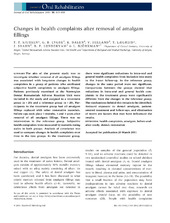Changes in health complaints after removal of amalgam fillings
Sjursen, Therese Thornton; Lygre, Gunvor Bentung; Dalen, Knut; Helland, Vigdis; Lægreid, Torgils; Svahn, Johanna; Lundekvam, Birgitte; Björkman, Lars
Peer reviewed, Journal article
Published version

Åpne
Permanent lenke
https://hdl.handle.net/1956/12852Utgivelsesdato
2011Metadata
Vis full innførselSamlinger
Originalversjon
https://doi.org/10.1111/j.1365-2842.2011.02223.xSammendrag
The aim of the present study was to investigate whether removal of all amalgam fillings was associated with long-term changes in health complaints in a group of patients who attributed subjective health complaints to amalgam fillings. Patients previously examined at the Norwegian Dental Biomaterials Adverse Reaction Unit were included in the study and assigned to a treatment group (n = 20) and a reference group (n = 20). Participants in the treatment group had all amalgam fillings replaced with other restorative materials. Follow-ups took place 3 months, 1 and 3 years after removal of all amalgam fillings. There was no intervention in the reference group. Subjective health complaints were measured by numeric rating scales in both groups. Analysis of covariance was used to compare changes in health complaints over time in the two groups. In the treatment group, there were significant reductions in intra-oral and general health complaints from inclusion into study to the 3-year follow-up. In the reference group, changes in the same period were not significant. Comparisons between the groups showed that reductions in intra-oral and general health complaints in the treatment group were significantly different from the changes in the reference group. The mechanisms behind this remain to be identified. Reduced exposure to dental amalgam, patient-centred treatment and follow-ups, and elimination of worry are factors that may have influenced the results.